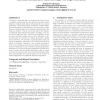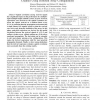30 search results - page 1 / 6 » Deriving quantitative models for correlation clusters |
KDD
2006
ACM
14 years 5 months ago
2006
ACM
Correlation clustering aims at grouping the data set into correlation clusters such that the objects in the same cluster exhibit a certain density and are all associated to a comm...
GLOBECOM
2008
IEEE
13 years 5 months ago
2008
IEEE
Spatial correlation among received signals has a significant impact on the performance of a multipleinput multiple-output (MIMO) system. In prior research, expressions were derived...
TCOM
2010
12 years 11 months ago
2010
A very general fading scenario is considered for which exact, closed-form formulas for the correlation coefficient of the instantaneous power at the output of a Maximal Ratio Combi...
CIBCB
2005
IEEE
13 years 6 months ago
2005
IEEE
— We present an integrative method for clustering coregulated genes and elucidating their underlying regulatory mechanisms. We use multi-state partition functions and thermodynam...
BMCBI
2010
13 years 4 months ago
2010
Background: The enumeration of tetrameric and other sequence motifs that are positively or negatively correlated with in vivo antisense DNA effects has been a useful addition to t...


